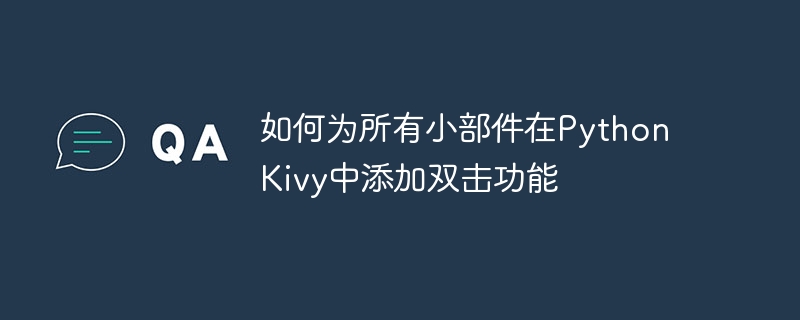Home >Backend Development >Python Tutorial >How to add double click functionality in Python Kivy for all widgets
How to add double click functionality in Python Kivy for all widgets
- WBOYWBOYWBOYWBOYWBOYWBOYWBOYWBOYWBOYWBOYWBOYWBOYWBforward
- 2023-08-21 12:25:071692browse

Python Kivy is a powerful framework for building multi-touch applications, allowing developers to create interactive and intuitive user interfaces. A common requirement in many applications is to be able to detect and respond to a double-click gesture on a specific widget.
Set up the Kivy application
Before implementing the double-click function, we need to set up a basic Kivy application. This step provides the basis for the implementation of subsequent code.
We first create a new Python file and import the necessary modules from the Kivy framework −
from kivy.app import App from kivy.uix.boxlayout import BoxLayout from kivy.uix.label import Label
Running the above code will open a Kivy application window with a vertical layout containing a label that says "Double click on me".
The App class is the base class for creating Kivy applications. The BoxLayout class is a layout container that arranges its children horizontally or vertically. We import the Label class, which represents a text label widget.
Next, we define a DoubleTapApp class that inherits from the App class. This class represents our Kivy application and contains the build() method, which returns the root widget of the application −
class DoubleTapApp(App):
def build(self):
layout = BoxLayout(orientation='vertical')
label = Label(text='双击我')
layout.add_widget(label)
return layout
In this example, we use a vertical BoxLayout as the main layout. We create a Label widget with the text "Double Tap Me" and add it to the layout using the add_widget() method. Finally, we return the layout as the root widget of the application.
To test the basic setup, we run the application by adding the following code at the end of the file −
if __name__ == '__main__': DoubleTapApp().run()
Running the application will display a window with the label "Double Tap Me". This ensures the initial setup works properly.
Detect double click
To detect double tap gesture on a widget, we need to handle touch events in Kivy application. Kivy provides a built-in Touch class that allows us to access information about touch events. We will use this class to detect double clicks.
In this step, we will define a custom widget that inherits from the Label widget and overrides the on_touch_down() method −
class DoubleTapLabel(Label):
def on_touch_down(self, touch):
if touch.is_double_tap:
self.on_double_tap()
return super().on_touch_down(touch)
def on_double_tap(self):
print("检测到双击!")
When you run the above code and perform a double-click gesture on a tab on the application window, the console will display the message "Double-click detected!".
In the on_touch_down() method, we check whether the is_double_tap attribute of the touch object is True. This property indicates whether the touch event corresponds to a double-click gesture. If it is a double click, we call the on_double_tap() method.
The on_double_tap() method represents a custom action that should be performed when a double-click is detected. In this example, we just print a message to the console. You can modify this method to perform any desired action, such as updating the widget's appearance or triggering specific behavior.
Add double-click function
Now that we have our custom widget with double-click detection, we can integrate it into our Kivy application. In this step, we will replace the Label widget with our DoubleTapLabel widget.
Update the DoubleTapApp class in the Python file as follows−
class DoubleTapApp(App):
def build(self):
layout = BoxLayout(orientation='vertical')
label = DoubleTapLabel(text='双击我')
layout.add_widget(label)
return layout
When you run the above code and perform a double-click gesture on a label on the application window, the text of the label will dynamically change to "You double-clicked me!".
Here, we instantiate a DoubleTapLabel widget instead of a regular Label widget. This ensures that our custom widget, capable of detecting the double-tap gesture, is used within the application.
Save changes and rerun the application. Now you will see the label "Double Tap Me" displayed. By performing a double-click gesture on the label, the message "Double-click detected!" will be printed on the console.
Custom double-click operation
In this step, we will explore how to customize the action performed when a double-click is detected. The on_double_tap() method in the DoubleTapLabel class is where you can define the desired behavior.
For example, let's modify the on_double_tap() method to update the label's text to indicate that a double-tap was detected−
class DoubleTapLabel(Label):
def on_double_tap(self):
self.text = "检测到双击!"
Now when a double click is detected on a label, the text will automatically change to "Double click detected!".
Feel free to experiment and adapt the code to fit your specific application needs. You can navigate to different screens, display popups, update multiple widgets simultaneously, or trigger any other functionality as needed.
in conclusion
Here we explored how to implement double-click functionality on any widget in Python Kivy. By leveraging touch events and customizing the on_touch_down() method, we made it possible to detect the double-click gesture on a specific widget.
We first built a basic Kivy application and then used the Touch class to detect double-click operations. We define a custom widget that inherits from the Label widget and override the necessary methods to handle touch events.
We successfully integrated double-click functionality into the application by replacing the existing widget with our custom widget. We also discussed how to customize the action performed on double-click detection, allowing for a customized and interactive user experience.
With this knowledge, you can enhance your Python Kivy application by integrating double-click functionality, allowing users to perform operations more efficiently and intuitively.
The above is the detailed content of How to add double click functionality in Python Kivy for all widgets. For more information, please follow other related articles on the PHP Chinese website!

